
A trad climber on Mont Blanc attempts to bump a blue Totem and falls with the piece in his hand. Here's how to avoid that.
The post Weekend Whipper: Trad Climber Tries to Bump a Cam—Then Rips It Out appeared first on Climbing.
]]>
Readers, please send us your Weekend Whipper videos using this form.
George Zhuravlev was high in the Alps and out of gear.
At more than 11,000 feet, Zhuravlev was leading a 0.3-sized finger crack on the fifth and final pitch of C’era una Volta il West (5.12a), a trad route on Rognon Vaudano below the Mont Blanc massif. He had just placed a blue Totem, but needed another one.
So Zhuravlev did what so many trad climbers do in this scenario: He grabbed his blue Totem and bumped it higher.
Unfortunately, just before he could re-place the Totem, his foot slipped. Zhuravlev flew off the wall, landing with a yell at 15 feet below his original position. When he landed near his belayer, he was still holding the piece he’d removed.
The dangers of bumping cams
Bumping—adjusting a cam to move it higher up—is risky for exactly this reason. While a cam is being moved, it’s not primed to catch the rock. Nevertheless, the move is very popular for trad climbers who accidentally run out of gear.
Jeff Jaramillo, the Head of Outreach and Gear Education at WeighMyRack, says that he most often sees people bump a cam when they get scared and want the rope above them. Zhuravlev’s case, he says, is a “prime example” of how bumping can end up extending a fall.
Not all bumps carry the same level of risk. For example, in offwidth climbing, climbers will often bump two pieces—one at a time—to ensure that one piece is always set in place to potentially catch a fall. When executed correctly, this strategy has the added benefit of keeping the rope out of the way of the climber’s knees and thighs.
Some gear is also easier to bump than others. According to Jaramillo, the design of a Totem cam, like the blue Totem that Zhuravlev was using, requires a lot of tension to load and unload. He finds that a stiffer cam, such as a Black Diamond C4 or Wild Country Friend, lends itself to bumping a bit more. “When it’s already placed in a crack and you give it a little bit of a push, it automatically starts to squish the lobes in a little bit,” Jaramillo explains, “so you don’t need as much pressure to collapse this style of cam as you do to collapse the Totem.”
Jaramillo’s advice for bumping
1. Bring more gear. “I generally try to avoid needing to bump a cam because that usually means that I’m not as prepared as I would want to be,” says Jaramillo. “For people getting into trad climbing, the things that you should look out for are, do I have all the gear that I’m going to need?” Don’t be afraid to add a few extra cams to your harness, especially if you’re new to leading trad.
2. Leapfrog your pieces. “Some people will backclean, where they’ll reach below themselves to grab a previous piece of gear—not the last one, but the one before it,” says Jaramillo. If the top piece is bomber, this practice minimizes the fall that could occur in transition.
3. Keep the piece in the crack. “If I was in [Zhuravlev’s] situation and really wanted that cam to be higher, personally, I would have wanted to just slightly disengage the cam, keep it in the crack, and push it upwards,” says Jaramillo. This move is slower but slightly safer than just pulling the piece out of the crack entirely and placing it higher. But it still doesn’t guarantee safety. “One of the things that happens when you fall is that you tense up, so you probably squish those lobes even more,” he adds. If you’re squeezing the lobes at all, assume that cam will be flying out with you.
4. Don’t bump until you’re totally secure. “When you are in a situation where you are bumping, the recommendation is usually to get to a spot where you’d be placing a piece again, and then bump to where you’d place the new piece,” says Jaramillo. Avoid adjusting your gear during a crux move or when you’re pumped.
5. Take. “If all you have is that one piece in front of you and you really need it to get higher, most of the time, I will just take,” says Jaramillo. “It’s so much easier to set the ego down for a second … if you’re scared or you’re pumped, and you’re right at that cam, take. Hang out for a second. Relax. Breathe. Get all the juices flowing where they need to be going again. Get thoughtful about where you’re going to go.” After a break, pull back on with a fresh mindset and bump the cam with full energy.
Happy Friday, and be safe out there this weekend.
The post Weekend Whipper: Trad Climber Tries to Bump a Cam—Then Rips It Out appeared first on Climbing.
]]>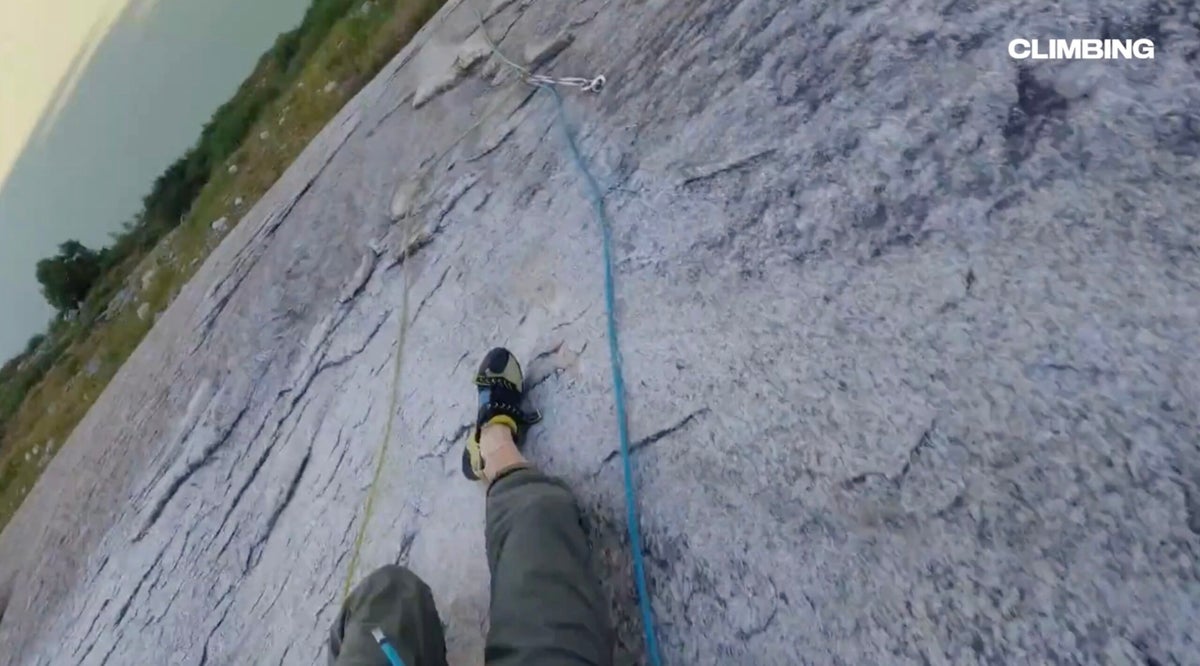
Thirty feet beyond your bolt? Above a cheese-grater slab? No thanks.
The post Weekend Whipper: A Slab Climber’s Worst Nightmare appeared first on Climbing.
]]>
Readers, please send us your Weekend Whipper videos using this form.
Are you planning to climb a runout slab this weekend? After watching this week’s whipper, you might think twice.
Earlier this month, Vincent Krause and a friend set out to climb Schweiz Plasir at Switzerland’s Grimselpass. “I was nearly at the belay of the first pitch, 10 meters (32 feet) above the last bolt,” Krause told Climbing. “I touched the only wet spot on the slab with my right foot while I wanted to clip into the bolted belay.”
Krause slid down nearly half of the pitch before he spotted the last bolt he had clipped. “Because of the angle and the friction of the granite, I slowed down and I grabbed the last placed quickdraw to stop the fall and avoid hitting the small ledge below me,” he said. In the process, he scraped off a thick layer of skin from his right hand, both ankles, and also received burn blisters on his fingers.
We won’t pretend to know what the “right” course of action really was for this fall. Surely sliding down that slab for another 30 feet—and skidding into a ledge, or the ground—would have been heinous. However, we must point out that Krause was extremely lucky to not de-glove his finger by grabbing the quickdraw in this fall. Krause experienced the absolute best-case scenario for a fall of this length and style.
“I put on bandaids and a lot of tape and finished the pitch, but was unable to use most of my fingers on the right hand,” Krause noted. “I handed the rack to my climbing partner who then led the remaining 12 pitches, up to 6b+ (5.11a) to the top.” Krause followed using his left hand and primarily his right thumb, since his remaining fingers were just too painful to crimp.
Krause reflected: “I learned that the Magnus Midtbø quote ‘On slabs we are all equal’ is true and that a 5c slab feels harder than a 6a crack.”
The post Weekend Whipper: A Slab Climber’s Worst Nightmare appeared first on Climbing.
]]>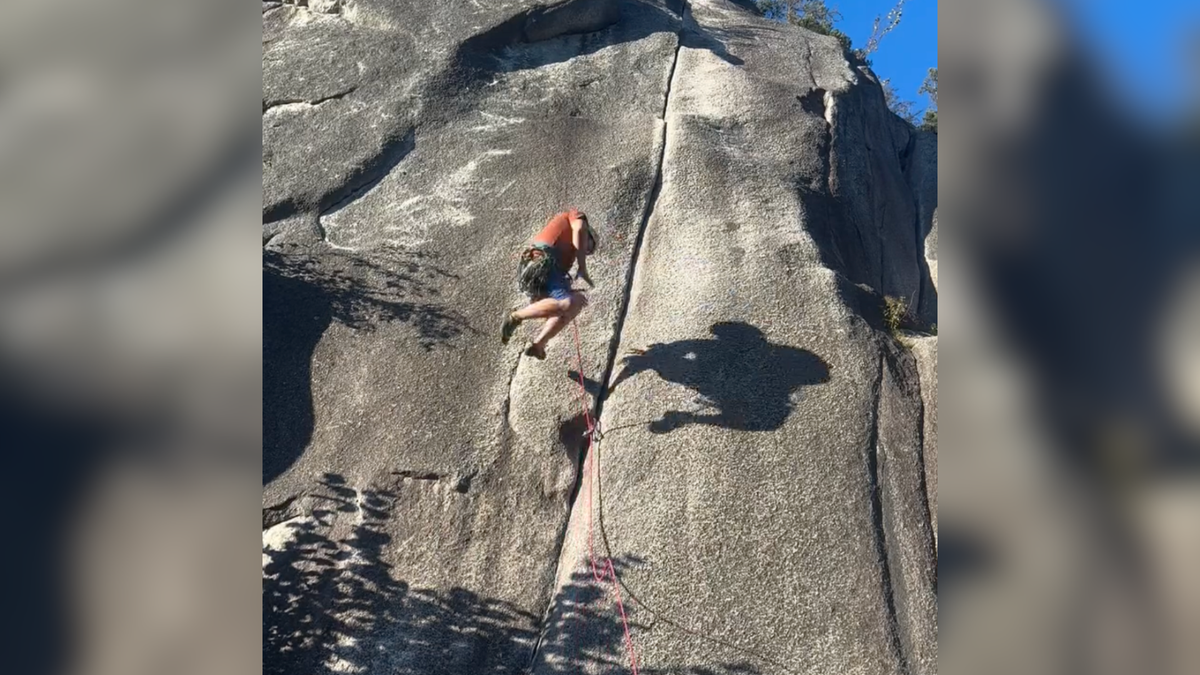
A 15-foot ground fall with, somehow, zero consequences
The post Weekend Whipper: An Expert Catch Saves This Climber from Serious Injury appeared first on Climbing.
]]>
Readers, please send us your Weekend Whipper videos using this form.
If there’s one thing that separates a regular member of society who’s watched Free Solo from a real rock climber—who, let’s be honest, has probably also watched Free Solo—it’s the understanding that a rope does not equal 100% safety.
Conversely, a ground fall does not, 100% of the time, equal injury and death.
In this Weekend Whipper, Oregon-based climber Luis Armando experiences both of these truths at once.
He’s just starting up Partners in Crime (5.11a), a 100-foot finger crack in Squamish, British Columbia. Armando had tried Partners in Crime before, but he’d never fallen in the lower section. On this day, however, it was particularly hot and slippery.
By the time he had climbed about 15 feet up from the ground, Armando had placed two pieces, and he’d unclipped the lower one—a fine choice, as the lower piece wouldn’t be useful as protection. He’s five feet above his last piece when he slips.
“Falling!” he yells.
Armando’s belayer, Matt Gowie, has Armando on minimal slack, but even so, the rope doesn’t tighten until Armando’s feet have nearly touched the ground. Gowie, being lighter than Armando, is yanked five feet up into the wall.
It’s the soft catch, plus the fact that Armando manages to stay upright, that results in zero injuries from what could have otherwise been a bone-crunching drop.
Later, Gowie tells Climbing, “[Armando] jumped right back up like a champ … and continued to climb the route.”
Armando himself didn’t seem phased. “All and all, bad place to fall, great catch, and great route,” he says. “Will be back.”
Happy Friday, and be safe out there this weekend.
The post Weekend Whipper: An Expert Catch Saves This Climber from Serious Injury appeared first on Climbing.
]]>
Yup, we don’t blame him for screaming.
The post Weekend Whipper: A 20-Foot Drop in First Person POV appeared first on Climbing.
]]>
Readers, please send us your Weekend Whipper videos using this form.
In this Weekend Whipper, Colton Davidson gives us a premium GoPro display of his lead fall on Space Ranger (5.12-), a 90-foot classic on Lookout Mountain in Chattanooga, Tennessee.
According to Mountain Project, this sport route includes multiple stacked boulder problems. The description calls it both a “Southern-style trad route” and “quintessential to the aspiring hardman/woman’s tick list.”
Davidson agrees, calling it a “sick classic.” In this fall, he pumps out at the top of a runout slab section, taking 20-feet of air time before landing safely on the rope. We don’t blame him for screaming.
Lucky for Davidson, the route is extremely overhanging and he suffered no injuries. “I learned that it is important to be patient when trying hard, and even though a route seems intimidating, just going for it is the ticket to success,” he says. He adds that he ticked the redpoint the next day.
Happy Friday, and be safe out there this weekend.
The post Weekend Whipper: A 20-Foot Drop in First Person POV appeared first on Climbing.
]]>
Check out this gnarly, 25-foot tumble.
The post Weekend Whipper: A Midair Somersault in South Africa appeared first on Climbing.
]]>
Readers, please send us your Weekend Whipper videos using this form.
A few weeks ago, we looked at how climbers can avoid getting their foot stuck behind the rope and flipping upside-down.
Unfortunately, even with great footwork, it’s still possible to invert in mid air, especially during a huge fall.
In this week’s Weekend Whipper, Greg Wright takes a 25-foot tumble on “Explorer” (24/5.11c) in the Western Cape province of South Africa.
He’s nearly at the top of the route when his foot pops. Although Wright drops feet first, his last piece of gear was a few meters below him and off to the right, so his rope is off-center. He lands, lurches forward over the rope, and flips.
“I was knocked around pretty bad and found myself hanging upside-down over a 550-meter drop,” he says. “My shin was cut up, my shin and forearm were bruised, and I had a bit of whiplash. It was a rough fall.”
Luckily, Wright was wearing a helmet, and he didn’t end up with any broken bones.
The lesson? “I extended a piece of gear unnecessarily, which added to the length of my fall,” he says. Sometimes, the extra rope drag is worth it.
Happy Friday, and be safe out there this weekend.
The post Weekend Whipper: A Midair Somersault in South Africa appeared first on Climbing.
]]>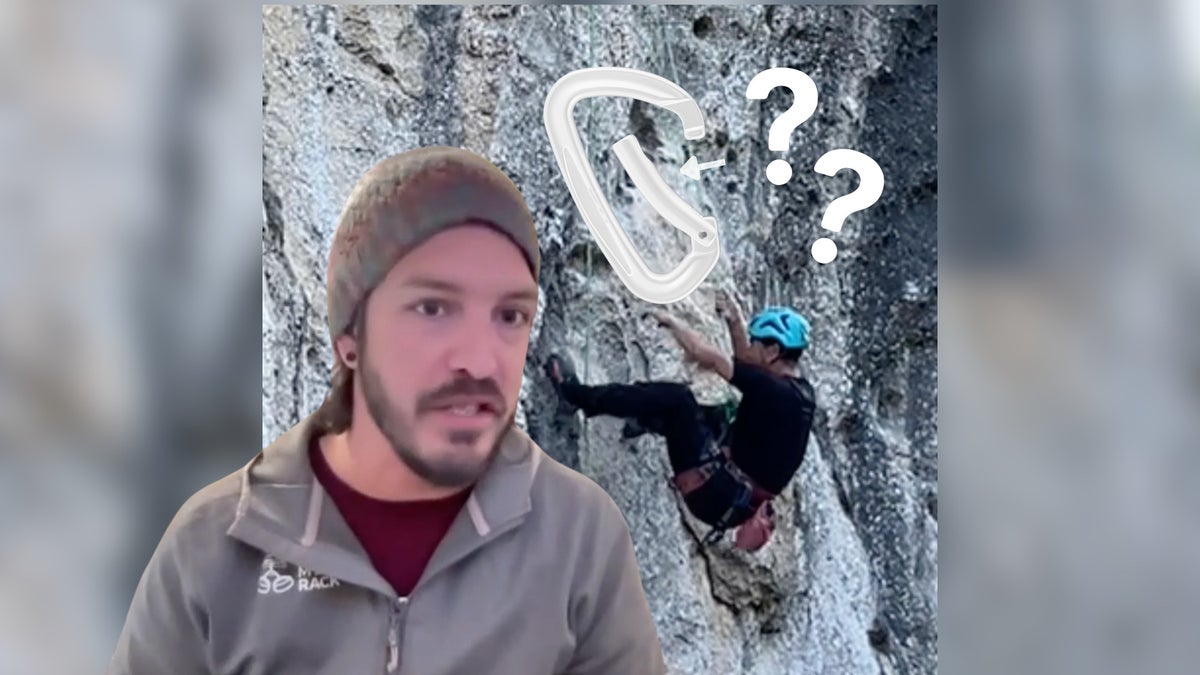
Gate flutter almost never happens. But when it does, it’s terrifying.
The post A Quickdraw Unclipped Itself Mid-Whip. Here’s What Went Wrong. appeared first on Climbing.
]]>
Readers, please send us your Weekend Whipper videos using this form.
If you haven’t heard of “gate flutter,” you’re in the majority. This incident with a carabiner is rare to experience, and even rarer to catch on film.
But when one climber falls on Singularity (5.12b), an 85-foot sport route in Yangshuo, China, we see a quickdraw come unclipped by itself up close.
Everything starts out normally. The climber is about two-thirds up the limestone route when he takes a hefty lead fall, landing in a soft arc about 30 feet below his fifth and final bolt. Physically, he’s completely fine. But when he lands face-to-face with his third quickdraw, he notices that it’s swinging in the air, ropeless.
A zoomed-in replay shows that the draw wasn’t back-clipped. Before he fell, the solid gate draw was closed around the rope. Then, during the fall, the rope bounced out—which means the carabiner’s gate must have opened on its own.
How did the quickdraw come unclipped?
A little disturbed, I hunted around the Internet for answers until I found a WeighMyRack blog post about gate flutter. According to the blog post, gate flutter happens when a carabiner’s spine smacks against the rock. At the right angle, and with enough force, this impact can cause the carabiner’s gate to bounce open. In the worst-case scenario, the rope could slide out of the quickdraw’s gate and render it useless to a falling climber.
Jeff Jaramillo, WeighMyRack’s Head of Gear Education and Outreach, confirms my suspicions. “Absolutely, I think what’s happening here is gate flutter,” he says over Zoom, “when a carabiner slaps up against the rock or a surface of some kind and the gate comes open temporarily. This is probably one of the best-filmed instances of this that I’ve seen.”
We move frame-by-frame through the video. Jaramillo points out that when the climber falls, he pulls at least twenty feet of rope quickly through the system. At high velocity, the friction of the rope pulls the bottom of the draw above the bolt. Any properly-clipped draw will be back-clipped if it’s flipped upside down, and that’s exactly what happens. However, this wouldn’t be an issue without this second part: the gate flutter. As it’s being flipped, the top of the draw hits the rock and its gate jumps open for a split-second. That’s just enough for the rope, which is still moving, to slip through.
According to Jaramillo, most of the people who know about gate flutter think that only solid gates, like the carabiner in this video, can experience it, but that’s not true: wiregates can still flutter open. “You’re probably going to see it more with the solid gate just because of the mass of the gate. There’s more potential energy that can be built up with more mass. As the carabiner swings over and stops, there’s more mass that needs to go somewhere,” he says. However, gate flutter has been shown to still happen with wiregates.
As a trad climber, I’m used to the idea that a properly-clipped bolt is the most bomber protection available. And while this climber had two other bolts above him, the idea that a healthy, perfectly-clipped bolt could become useless in an instant is an uncomfortable thought. So how can people avoid this?
Tips for avoiding gate flutter
“Unless you’re the person who bolted this route, I don’t think there’s much you can do to avoid where this carabiner hit that wall,” says Jaramillo, “short of maybe choosing a shorter or longer draw. Longer draws have a greater chance of flopping around.” He recommends that route developers avoid placing bolts directly below tufas or bulges, where a carabiner is most likely to flip up and hit the rock.
Taking shorter falls, however, will minimize the risk of having the rope come unclipped. “If this fall wasn’t so big, there wouldn’t be that much rope moving through the quickdraw, so the quickdraw wouldn’t have had time to get all the way upside down like it did,” he says.
Another precaution is using a locking carabiner at the end of the draw. This could take significant time and energy on lead, but would ensure the rope doesn’t escape.
Thankfully, gate flutter is still incredibly rare. “[Whether you’re] sport climbing or trad climbing, you’re in a system, and there are multiple pieces for a reason,” says Jaramillo, “so if you’re worried about one particular piece coming undone, I would say the pieces lower to the ground that could result in a groundfall would be the ones that I’d be worried about. That’s why I’m seeing more people locking the first or second draw if that’s a concern for them.”
Happy Friday, and be safe out there this weekend.
Original video credit: Mou Ding
The post A Quickdraw Unclipped Itself Mid-Whip. Here’s What Went Wrong. appeared first on Climbing.
]]>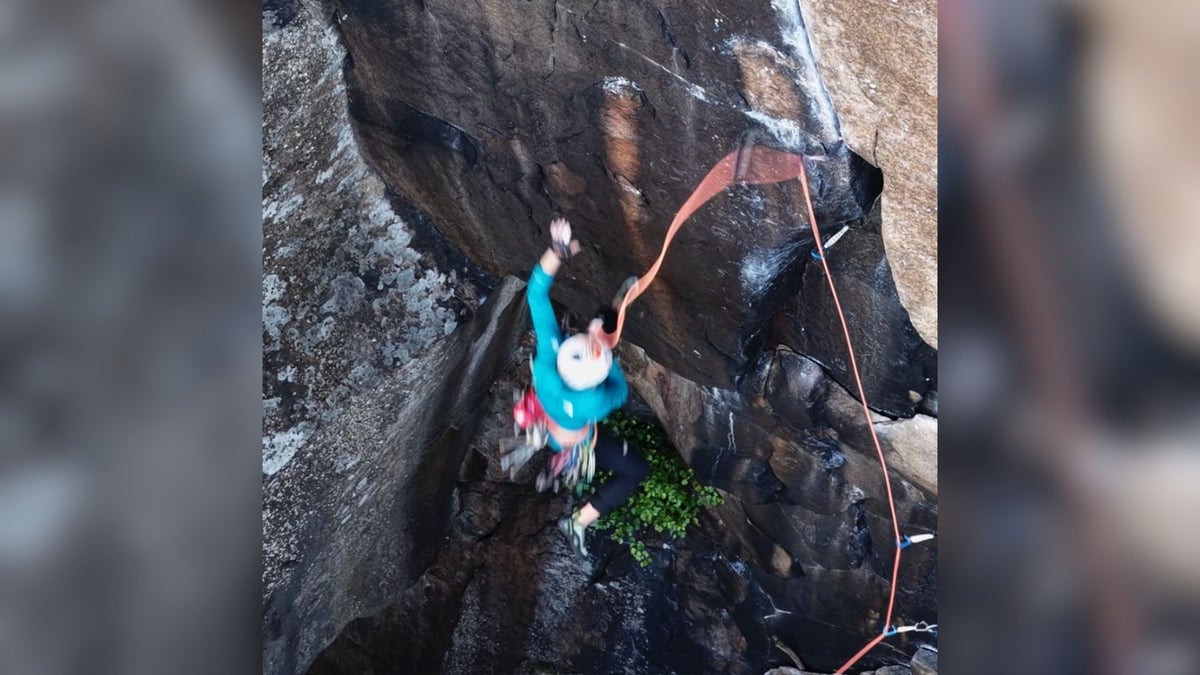
Fresh from the Alps, Fay Manners gets some air time.
The post Weekend Whipper: Ripping Cams in a Swedish Finger Crack appeared first on Climbing.
]]>
Readers, please send us your Weekend Whipper videos using this form.
Fay Manners has had a busy winter.
After ice and snow climbing in Scotland, putting up the first ascent of Apollo 13 (5.12+, 13 pitches) in Patagonia, and opening two new ski lines in the Alps, the British alpinist drove to Sweden this month to focus on single-pitch trad climbing.
As part of her warm up for rock season, Manners attempted an onsight of Trampoline (grade 7/5.11b) at Brodalen. This moderate crag in Bohuslän is known for its short approaches, rose-colored granite, and more than 1,000 single-pitch routes.
She was midway through the 80-foot climb, in a 10-foot finger crack stretch, when she placed a .5-sized purple totem—one that didn’t quite fit.
“I put it in when I was pumped and it was the wrong size,” she says, “but I didn’t have the energy to change it to a smaller size, so [I] just carried on.”
When Manners slips out of the finger jams, the purple Totem pops. Her five-foot fall extends to 15 feet, but the very next piece—also a purple Totem—catches her as she swings into the wall, feet first. Compared to most Whippers we’ve seen, it’s a gentle fall.
Manners says she intends to stay in Bohuslän for a few weeks to climb more granite trad routes. We can’t wait to see what’s next for her.
Happy Friday, and be safe out there this weekend.
The post Weekend Whipper: Ripping Cams in a Swedish Finger Crack appeared first on Climbing.
]]>
A narrow miss in an even narrower slot.
The post Weekend Whipper: First Trad Fall … in a Chasm?! appeared first on Climbing.
]]>
Readers, please send us your Weekend Whipper videos using this form.
A climber’s ideal first trad fall—or, at least, the safest possible first trad fall—takes place on bomber gear with a clean landing.
That wasn’t quite the case for Joshua Johnson, who decided to take his first-ever fall on gear on Heart of Darkness (5.11a), a popular warm-up in Joshua Tree.
Heart of Darkness ascends a 40-foot splitter up a chimney that’s too wide for a full-body bridge. That means any climber who leads it risks hitting the back of their head on the wall behind them.
According to Johnson, he “aided up the route, built a nest” of several pieces close together, then “placed a single .5 above the nest, climbed to the anchors, and let go.” Presumably, his goal was to test the effectiveness of his .5 cam placement with a lead fall.
Luckily, when Johnson removed his personal anchor system and dropped from the anchors onto the .5, he absorbed the 25-foot drop with bent knees and perfect form. His .5 held, and his friends erupted into cheers.
If he had leaned back slightly further, his first trad fall might have ended in a hospital stay. Instead, Johnson’s head misses the chimney behind him by about a foot, while the extra cams on his harness brush the rock. Even though he’s wearing a helmet, we probably would have chosen a different route to test our gear on, with less potential for a back-of-the-head concussion or giant back contusion.
Happy Friday, and be safe out there this weekend.
The post Weekend Whipper: First Trad Fall … in a Chasm?! appeared first on Climbing.
]]>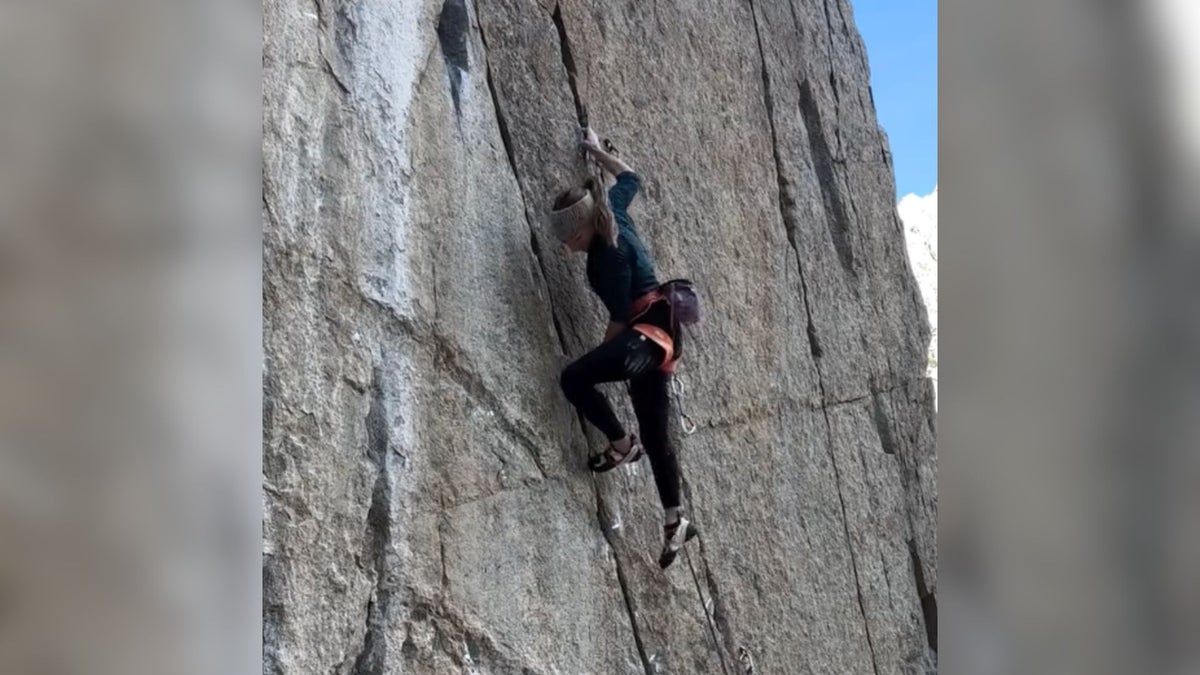
How to not flip upside-down
The post Weekend Whipper: Lessons in Lead Footwork With Michaela Kiersch appeared first on Climbing.
]]>
Readers, please send us your Weekend Whipper videos using this form.
It’s a normal day for Michaela Kiersch. The 30-year-old professional climber—the first woman in the world to send both V15 boulder and 5.15 sport—is trying one of the hardest routes in California: Everything is Karate (5.14c/d) in Pine Creek Canyon, near Bishop.
Unlike most of Kiersch’s recent big-name projects, this route ascends a sloping seam, requiring what she calls “ultra tech climbing” and finger locks.
“This style is not an obvious strength for me,” she writes on Instagram, “so it’s been cool to see progress every sesh.”
Kiersch is midway up the 70-foot route when she sticks the crux move and “bobbles the feet,” as she describes it. She’s about to take a fall—and from our perspective, she’s in a precarious position. She’s five feet above the last bolt and her feet are just a few inches from slipping under the rope. In past situations like this, we’ve seen falling climbers catch their ankle in the rope and get flipped upside-down.
But this is where her experience as a sport climber shows. When Kiersch falls, dropping at least 15 feet from her last extended draw, she’s careful to keep both her feet on one side of the rope—the side she’s going to fall toward. By the time she whips out of the frame, the rope is safely in front of her.
Some climbers try to keep the rope between their feet, but that’s not the safest technique for lead climbing, especially on a diagonal. It’s an easy way for the rope to get wrapped around your ankles or legs, which can lead to a flip whip. Instead, we recommend keeping the rope in front of your legs at all times.
Happy Friday, and be safe out there this weekend.
The post Weekend Whipper: Lessons in Lead Footwork With Michaela Kiersch appeared first on Climbing.
]]>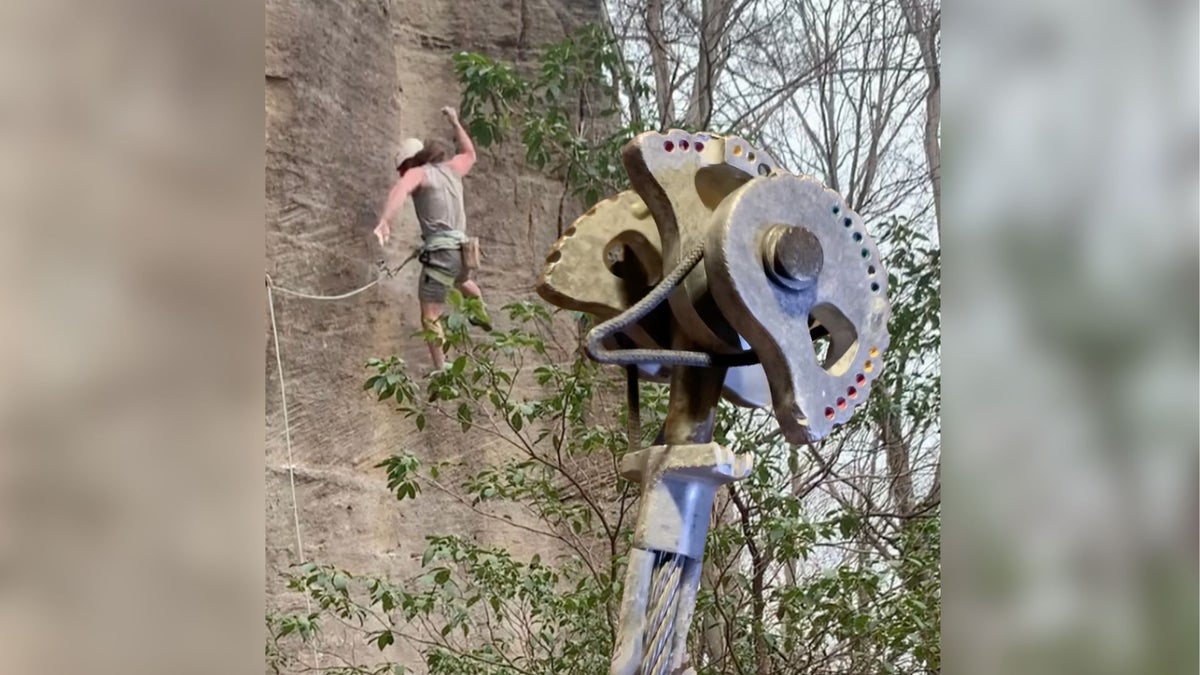
On ‘Blockage Project’ (5.13+) in West Virginia, a guidebook author accidentally sacrifices a cam for a second attempt.
The post Weekend Whipper: Black Metolius Cam Explodes on R-Rated Grit Route appeared first on Climbing.
]]>
Readers, please send us your Weekend Whipper videos using this form.
In this Weekend Whipper, Andrew Leich is on his second redpoint attempt of Blockage Project (5.13+ R), a 40-foot gritstone trad route in Cheat Canyon, West Virginia. It’s an area Leich knows well—he’s the author of two guidebooks to Cheat Canyon.
About halfway up the route, Leich plugs a Black Metolius Master Cam—his third piece—into a .75-sized slot. He’s moving carefully up the sloping crimps, but his hands are beginning to sweat.
“I kind of let the nerves get to me, and I had lost some skin on my first attempt,” he tells Climbing. With the Black Metolius at his waist, Leich feels himself losing friction. He lets out a roar of effort, then slips off.
At first, it seems like Leich will take, at most, a three-foot fall. But Blockage Project is rated R for a reason.
Instead of catching him, the Black Metolius explodes out of its slot. Leich tumbles about 15 feet, swiping a tree branch and swinging into his belayer’s shoulders. He lands just three feet off the ground.
When he catches his spinning cam, he finds that his initial one-foot fall broke part of the Black Metolius. Specifically, it damaged part of the aluminum clasp, which holds the 13mm webbing that retracts the cam lobes, snapped off, leaving half the cam unable to retract.
“Unfortunately now, I can’t try it [again] until I buy a new cam,” says Leich, adding that the existing rock slot now has a broken edge, but will still fit gear.
Happy Friday, and be safe out there this weekend.
The post Weekend Whipper: Black Metolius Cam Explodes on R-Rated Grit Route appeared first on Climbing.
]]>
Last year, the Saudi national champion survived every climber's worst nightmare. But what happened to her afterward?
The post After a Horrific Belaying Accident, Sara Al Qunaibet Moves Through Recovery appeared first on Climbing.
]]>
The world watched her fall.
In July 2024, Sara Al Qunaibet tied in for her warm-up route at a popular gym in Switzerland. The 24-year-old Saudi competition climber was on an official training trip with her five teammates, all of whom were preparing for the upcoming World Cup in Seoul.
On the slightly overhanging route, Al Qunaibet climbed smoothly through 50 feet, clipping 11 draws. Then she leaned back for a practice fall—but the rope never tightened. Instead, she hit the ground at approximately 38 miles per hour.
Seven months later, when she posted a video of her accident on Instagram, it went viral. Even with faces blurred, it racked up eight million views and 5,000 comments in two months.
The Internet responded with a mix of sympathy and fury. On YouTube, the climbing channel HardIsEasy broke down exactly what the belayer was doing wrong: no hands on the brake strand. Barely two fingers around the rope. Not even looking at his climber. And obviously distracted, chatting with someone else.
“What’s even more disappointing is that no one took responsibility or acknowledged the mistake,” wrote Al Qunaibet. Most of the comments attacked the belayer for obvious negligence. Others blamed the second coach for distracting the belayer. “At least six people who could have [stepped in] didn’t,” wrote Will Gadd after reposting Al Qunaibet’s video in full.
When I first saw Al Qunaibet’s video, I was more shaken than I’ve been watching any Weekend Whipper. The comp climber did everything right; she had no reason to fear a belay from her coach, the person that should have been most qualified to catch her.
But another question pulled from the back of my mind. What happened to Al Qunaibet after the paramedics came? And what was her story?
“It Was My Sport”
Before the accident, Al Qunaibet wasn’t simply a competition climber; she was a breakout star on Saudi Arabia’s brand-new national team.

She grew up in Riyadh, the centrally located capital of Saudi Arabia. As a kid, she “tried many sports, but I felt like none of them was my sport,” she tells Climbing. In 2018, during her penultimate year of university, she walked into a small climbing gym outside her school and immediately felt at home on the wall.
Within the same few months, the Saudi Climbing and Hiking Federation (SCHF) was established, chaired by Prince Bandar bin Khalid Al Faisal Al Saud, the grandson of the late King Faisal. Al Saud is an avid rock climber and mountaineer. In 2012, he was the first Saudi to complete the Seven Summits, and for years he’s been pushing for the development of Saudi rock climbing, both indoors and outdoors. When the SCHF started hosting competitions in 2019, Al Qunaibet signed up, although she remembers her first competition experience as less than promising. “There were only six girls and I didn’t even qualify for the [top four spots in the] final,” she says. “That was funny.”
But she stuck with it. In 2020, Al Qunaibet entered her second national competition, earning the last podium spot. “It was a really good feeling to take third,” she says.
By 2022, Al Qunaibet had found her rhythm, winning gold in the National Lead Cup, gold in the National Boulder Cup, and bronze in the Saudi Games. In 2023, she won gold again in the National Lead Cup, silver in the National Boulder Cup, and gold in the Saudi Games. The SCHF selected her for their first national team roster.
In 2023, Al Qunaibet made her IFSC debut at the Asian Cup, which was hosted in Riyadh (her IFSC results are displayed under the name Sara Alqunaybit). Although the Saudi team, as the newest to join the IFSC, didn’t have any athlete qualify for the finals, Al Qunaibet relished the chance to compete on the international circuit. “The best part of joining more competitions was meeting the other athletes and going out afterwards,” she says. “There was something that bonded us.”
In between competitions, Al Qunaibet enjoyed traveling with friends to climb in Thailand, Jordan, and Spain. In Saudi Arabia, her favorite crag was Tanomah, a popular climbing area in the southwest of the country. She says that the granite routes regularly draw climbers from all over: “A lot of international climbers gather there, so I can see a lot of different faces. It’s one of the most beautiful places in Saudi.”
Outdoors, she figured out her favorite types of climbing. “I was way more into slab than other styles,” she says, adding that she enjoyed how specific the moves were. During one trip to Thailand, she even spotted 5.14 slab climber Anna Hazelnutt. Al Qunaibet calls her “the Queen,” but at the time, was too shy to say hello.
Despite her love for outdoor climbing, Al Qunaibet kept her focus on indoor competitions, where she was excelling. On February 15, 2024, she entered the National Lead Cup again—and for a third year in a row, won first place. When she stood on the podium on the 17th, sporting a gold medal, she held her arms around her two friends, beaming. On that day, she was the best female competition climber in the country.
In January 2024, one month prior to Al Qunaibet’s win, the Saudi national team started training under two new coaches from France. (On Al Qunaibet’s request, Climbing has redacted both of their names.) The coaches were by no means inexperienced; both had recently been national coaches for teams in Europe.
The Saudi team completed a training camp in Innsbruck, Austria in April. Their next one, in July, was based in France, but on the second day, the team crossed into Switzerland to visit a popular Geneva gym (Al Qunaibet requested that we redact the name of the gym). The gym was world-class, with over 48,000 square feet of climbing and walls up to 50 feet high.
Al Qunaibet, who doesn’t usually film her warm-up, set up her phone camera on a whim and asked her coach for a belay.
The Aftermath
After getting dropped, Al Qunaibet’s first reaction was rage.
“No one called the police. They should have come and written a report about the accident,” she insists. “I wasn’t confused. Everyone was trying to calm me down, saying maybe the grigri had malfunctioned, but I knew he made a mistake. I knew he held the grigri in the wrong way.” She had heard the coach speaking in French while she was climbing, and knew that he had been distracted.
After a short ambulance ride to a nearby Geneva hospital, Hôpitaux Universitaires de Genève, Al Qunaibet got her diagnosis: Fractures in both feet and two broken vertebrae in her back.
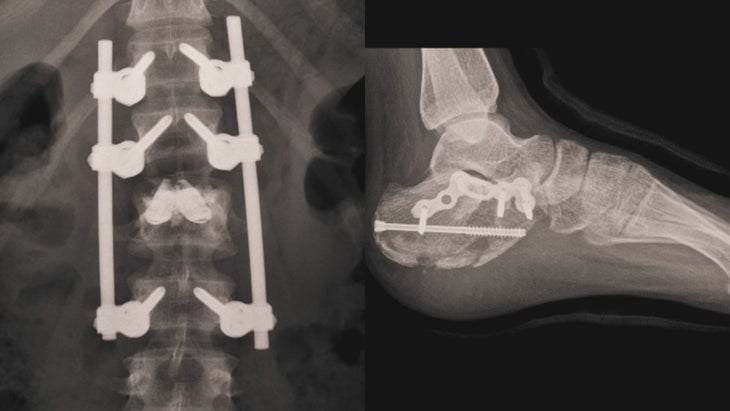
“The first two weeks, I didn’t know what was going to happen,” she says. “How am I going to spend the rest of my life?”
The doctors performed surgery on both her left foot and her back, leaving metal rods inserted into both to help stabilize the broken bones. According to Al Qunaibet, the Saudi embassy in Switzerland stepped in and covered all costs.
Her teammates continued the training camp with the same two coaches. Five days after the accident, the SCHF fired the coach who had dropped her. “I was furious,” she says. “He just dropped me and then he kept training the team for five days.” However, according to Al Qunaibet, an investigation did not begin until six months later, in 2025. In addition, the SCHF kept the second coach—who had witnessed the improper belaying—for the rest of the year.
An employee for the Geneva gym told Climbing that the facility, like most climbing gyms in Europe, does not require any belay tests for its visitors.
After surgery, Al Qunaibet returned home to Riyadh in a wheelchair. Another athlete from the national team took her spot at the World Cup in Korea that October.
“I felt like I was nothing,” she says. “I was replaced so quickly, without any acknowledgement of what happened. As a national team athlete, I felt zero respect. Like ‘Okay, you’re broken now. Bye-bye.’”
Searching for a New Normal
When I speak to Al Qunaibet over video chat, she’s sitting upright in bed, with her friend’s newborn kitten, Yoka, on her lap.
It’s been nine months since the accident. Her Instagram profile is full of X-rays, old climbing videos from Thailand and Austria with nostalgic captions, and a highlight album of rehab exercises titled “Coming Back.”
At the moment, three of her former teammates from the July 2024 training camp are preparing to head to the World Cup in Keqaio, China.

“I don’t think I’ll be in a harder situation than this, even emotionally,” she says. “Everything was just gone in a split second. I didn’t want to talk about it at first. I even deleted my social media for quite some time.”
When she got home, Al Qunaibet spent two and a half months in a wheelchair. Having never been sick or experienced any health issues before, she struggled to adjust to her new limitations. “If I wanted to just turn off the lights, I needed help,” she says. “I have a lot of respect for those who need to be in a wheelchair for the rest of their lives.”
In October, she started to learn how to walk again. “Once I started walking, I started being independent,” she says. “I started driving again, too. That was really nice.” She’s become laser-focused on recovery, going to the gym three times per week for physical therapy exercises.
For now, however, climbing remains out of reach. Al Quanibet says she’s not yet cleared to wear climbing shoes, which are too tight for her feet, or take any impact in either foot, including on top rope. “I’ve been hangboarding,” she says, then corrects herself: “I was hangboarding, but it’s really hard to keep up the motivation, even if I have all the equipment. I see everyone else climbing, and I’m just hangboarding. It’s quite hard to see my hand getting way softer than it’s supposed to be.”
The crux of her recovery is waiting to see if she’ll need to get more surgeries in her back and left foot. Her doctors say it’s too soon to tell. The movement in her back and left ankle, she says, is noticeably limited and often painful. Online, she’s been closely following Kyra Condie, who had 10 vertebrae in her spine fused in 2010 and later competed in the 2020 Olympics. After her accident, Al Qunaibet watched Condie’s story highlights and listened to her podcast. “Her back is even more complicated than mine,” she says, calling Condie “so inspiring.”
Later in 2024, Al Qunaibet’s teammates spotted the coach who dropped her at another IFSC event. In February 2025, she made the decision to post her accident video. Going viral, she explains, “was good because so many people noticed who [the coaches] were. I don’t want anyone else to go through this.” She hopes, at minimum, for the IFSC to ban both coaches from future competitions.
On a personal level, Al Qunaibet says she just wants to climb hard again. However, in the meantime, she’s been switching gears to a different, low-impact, physio-approved activity: swimming. During a past trip to Mallorca, she didn’t know how to swim, so she had refrained from deep water soloing. “I was planning to do it, but it’s just really scary when you know you can’t swim, so I just went there and watched,” she says.
Next time, it’ll be different. Al Qunaibet is already making a list of places around the world she wants to visit once her body heals. “I really miss climbing,” she says. “I think it will take time to take falls, but it’ll happen eventually. But yeah, deep water solo? That’s the plan.”
The post After a Horrific Belaying Accident, Sara Al Qunaibet Moves Through Recovery appeared first on Climbing.
]]>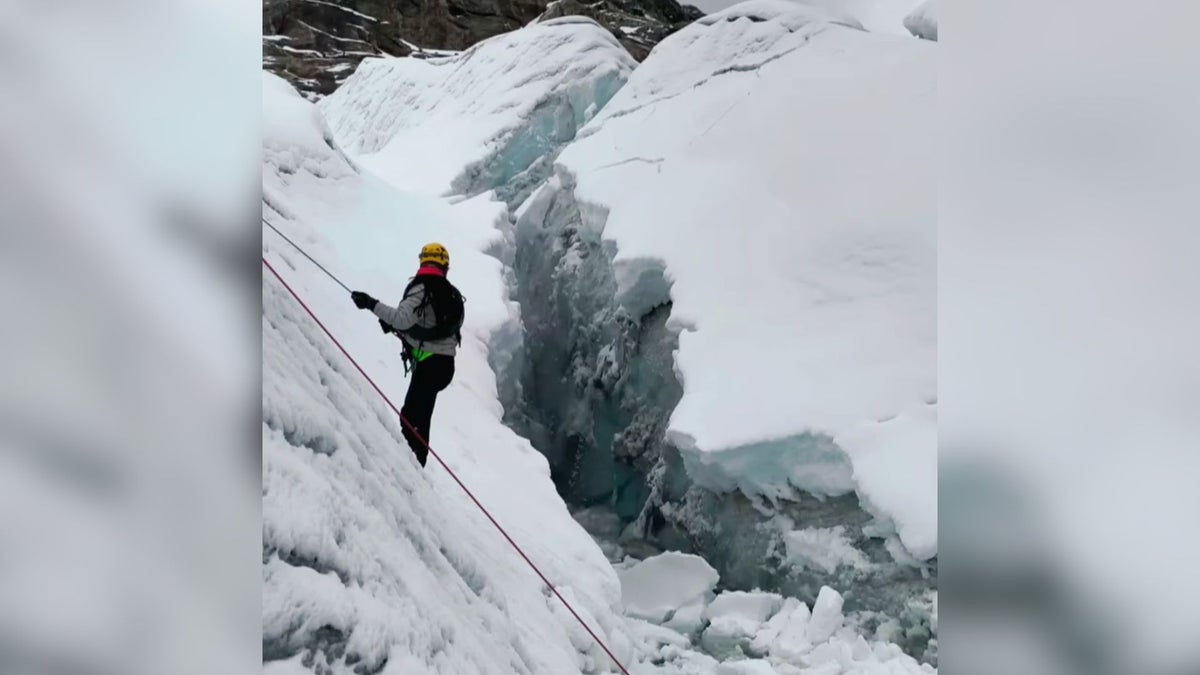
In an instant, this practice rescue becomes real.
The post Weekend Whipper: The Ground Falls Out From Under Them (Literally!) appeared first on Climbing.
]]>
Readers, please send us your Weekend Whipper videos using this form.
On April 13, a group of climbers were in the middle of their International Mountain Rescue course in the Peruvian Andes when they got a real-life pop quiz.
The climbers were on Mount Vallunaraju, an 18,655-foot peak and popular guiding destination in Huascaran National Park near the city of Huaraz. Three of them were hanging in harnesses over a snow bank, simulating a rescue and waiting for their teammates to hoist them back up.
Suddenly, a 20-foot serac behind them broke off into three pieces, each sinking into an adjacent glacial lake. Then the snow bank began to collapse, too, right below the climbers’ feet.
“I felt real fear when [the serac] started to break,” wrote Javier Rivadeneira, one of the course participants, on his Instagram post. Rivadeneira was above the fray, holding a back-up line for his partner, who successfully pulled up his “fallen climber.”
His friend Jose Forero captured this video, throwing up a peace sign and selfie as truck-sized icebergs bobbed and sank behind him.
Luckily, the rescue drill succeeded. No one was hurt, and the group soon moved to steadier ground. The course, hosted by the Association of Mountain Guides from Peru (AGMP), included climbers from Ecuador, Mexico, Colombia, and Switzerland.
“I’m grateful for the years of experience and what we learned in the course these past few days,” added Rivadeneira.
Ice calving is a natural process, but it’s worth noting that Peru hosts nearly 70% of the world’s tropical glaciers, including over 700 glaciers in the Cordillera Blanca (“white belt”) of the Andes.
Vallunaraju’s glacier, in particular, is the subject of a 2025 International Mountain Conference study linking black carbon, caused by human pollution, to accelerated snowmelt.
Happy Friday, and be safe out there this weekend.
The post Weekend Whipper: The Ground Falls Out From Under Them (Literally!) appeared first on Climbing.
]]>